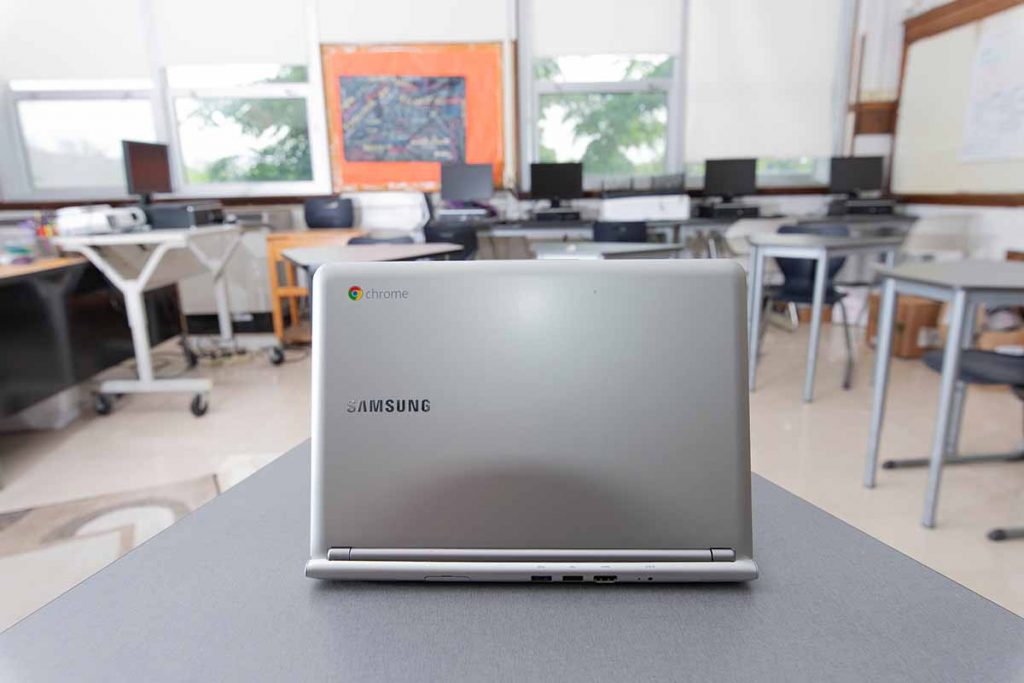
A data wiping company executive makes the case that ITAD firms can benefit by wiping and reselling devices, particularly Chromebooks, from K-12 schools. | CC Photo Labs/Shutterstock
The sale of Chromebooks skyrocketed during the height of the pandemic, with 275% year-over-year growth in the first quarter of 2021, according to market analysis firm Canalys. Many of these devices made their way to K-12 schools to support distance learning as those schools closed to stop the spread of COVID-19. Now that schools across the country are back in session, they are faced with a conundrum: Either store or destroy the deluge of Chromebooks. These are both terrible options from a security, physical space and sustainability standpoint.
According to an EdWeek Research Center survey from April 2022, 85% of students had a school-issued digital learning device, such as a Chromebook or iPad. Collectively, this means such devices are present at more than 100,000 K-12 schools and used by approximately 50 million students – this adds up to a lot of computers, tablets and laptops. Many of the discarded, broken or end-of-life devices are taking up space in storage rooms with existing personally identifiable information (PII) data on them that could pose serious security threats to schools, teachers and students.

Russ Ernst
On top of the security concerns, e-waste has reached crisis levels. As sustainability increases in importance across the globe, the ability to reuse IT equipment – instead of destroying or even recycling it – plays a big role in achieving sustainability and environmental, social and governance (ESG) objectives. One important component of that is tackling e-waste, which is the fastest-growing waste stream in the world, according to the World Economic Forum (WEF). More than 53 million metric tons of e-waste is generated annually, with only 17% collected and documented. A good portion of the e-waste generated worldwide is sent to developing countries for processing, exposing workers to toxic heavy metals. These metals, which include lead, chromium, beryllium and palladium, then contaminate the food supply by mixing with the air, water and soil.
To deal with a lack of space for unused devices, many schools look to their ITAD partners to take them off their hands. This is an ideal opportunity for ITAD firms to educate the K-12 school administrators and IT staff on how to take a more sustainable approach to disposing of unused or end-of-life Chromebooks. ITADs can take the lead in providing their school partners with more sustainable options to manage these Chromebooks and decrease the number of devices that end up in landfills by instead putting them back into the circular economy.
It’s time for ITADs to prioritize sustainability
The ITADs that build their businesses around sustainable best practices will be in great demand in the years to come. With rising temperatures, droughts and climate change top of mind for governments, businesses and other organizations, ITADs can tap into the new business opportunities resulting from the emerging “climate economy.”
For those ITADs focused on the education sector, it’s critical they work with K-12 schools and their technology partners to execute and implement policies that guide the responsible management of Chromebooks, and other end-of-life devices, with the goal to reduce e-waste, protecting the environment in the process. These policies are a win-win-win for schools, students and ITADs. Schools can use policies that create “greener” campuses and leverage these efforts to create a learning experience for students, most of whom are aware of the climate crisis and want to do their part to create a better world.
The first step is to erase the data on the devices. By automating the data sanitization process, operating costs are minimized because device processing time is reduced to mere minutes. This allows ITADs to prepare more devices for reuse in less time, and to more quickly determine which devices need to be set aside for component and material recycling. This in turn increases their return on investment.
Using quick and secure cryptographic erasure of all user data, including settings, apps, files, etc., the data sanitization process for each device takes just about five minutes and renders the data unrecoverable. Upon completion, the ITAD can provide a tamper-proof, digitally signed certificate for each erased device to simplify reporting and meeting compliance mandates.
The data sanitization process, with the added insurance of certification, is the most secure and cost-effective way to put devices, including Chromebooks, back into the circular economy. ITADs can then sell working used devices and/or components once they’ve been thoroughly tested, instead of contributing to the growing global e-waste crisis.
The bottom line is ITADs that prioritize sustainability will create new revenue streams by supporting the schools and organizations that are committed to adopting more environmentally friendly policies, including the responsible management of end-of-life Chromebooks and other IT assets. Not only will ITADs boost revenues by funneling Chromebooks into the resale supply chain and the circular economy, they’ll also be doing their part to decrease e-waste, making a positive impact on the environment in the process.
Russ Ernst joined Blancco in 2016 as executive vice president of products and technology, and in September 2022 he was named chief technology officer. He is responsible for defining, driving and executing product strategy across both the data erasure and mobile diagnostics product suites. Blancco recently published its 2022 ESG report, which noted that the company’s technology erased electronics weighing over 163 million pounds between July 2021 and June 2022, up 8.7% from the previous year.
The views and opinions expressed are those of the author and do not imply endorsement by Resource Recycling, Inc. If you have a subject you wish to cover in an op-ed, please send a short proposal to [email protected] for consideration.



